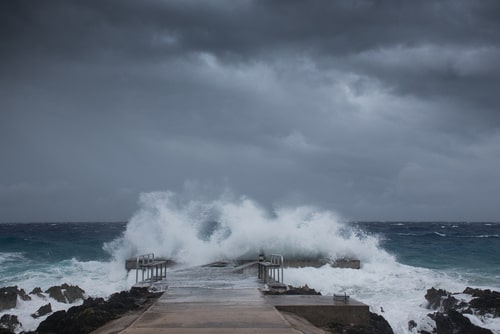
Republished with the kind permission of Insurance Day. Recent events like Hurricane Laura or COVID-19 have highlighted the significant exposure the interconnectivity of commercial risks represent to insurers writes Suki Basi in Russell Group. (To read a PDF copy of the article, please scroll down to the end of the article)
The growing concentration of risk in ports, airports and refineries, often in areas of high risk to natural disasters is, rightly, a major cause of concern for specialty underwriters. Global broker, Aon has reportedly undertaken a new risk modelling system for marine re/insurers to highlight the threat of hurricanes, but are the underwriters really aware of their exposures?
As Hurricane Laura continued to gather pace on route towards the Gulf Coast towards the end of August, those monitoring the event saw the storm, labelled a Category 3 hurricane, potentially making landfall somewhere between Texas and Louisiana. Aviators had major concerns over the storm surge, which could have caused extensive damage to grounded aircraft at George Bush International Airport (IAH) in Houston.
Russell Group’s ALPS Visualiser platform, for example, showed the number of aircraft grounded at IAH as 165 with an exposure value in excess of $2bn, the majority belonging to United Airlines.
Hurricane Laura eventually made landfall on the US’s Gulf of Mexico coast early on the 27th August, threatening an “unsurvivable” surge of seawater in the heartland of American oil refining, natural gas exports and petrochemicals production. The US National Hurricane Center (NHC) said Laura was an “extremely dangerous hurricane” with “extreme winds and flash flooding” expected in coastal areas of Texas and Louisiana.
Laura’s winds of up to 150mph raised fears of huge damage to local infrastructure, according to the NHC, which issued a warning for a 400-mile swath of the Gulf coast from Freeport, Texas, to the Mississippi River. Laura crossed the US coast near the Louisiana town of Cameron. The centre of the storm was on track to pass between Port Arthur, Texas, and Lake Charles, Louisiana, two of the most important oil refinery hubs in the country.
Refineries with a total capacity of 2.2m barrels per day of oil were closing plants or reducing volumes in advance of the storm, according to S&P Global Platts Analytics — about a quarter of the refining capacity on the Texas and Louisiana coasts. The affected refineries included North America’s largest, Motiva Enterprises’ 630,000 b/d plant at Port Arthur, as well as Citgo’s 425,000 b/d refinery at Lake Charles, S&P said.
Events like Hurricane Laura or COVID-19 have not only disrupted trade but also highlight that decision makers have a real lack of awareness of the interconnectivity of trade, and how this affects opportunity, risk, and exposure.
The pandemic, for example, has delivered true economic and societal risk, but business is still exposed to the same climate, digital, geopolitical and governance risks prevalent as before. What this means is that during the “recovery of trade”, business will need to form a connected view of the effects of these PESTLE risks on its future trade.
In my view, future sustainability and business success will be built on a better knowledge of connected trading risk and exposure. Almost 80% of goods by weight are shipped and almost 30% of goods are freighted by value. In fact, more than $1 trillion of goods are freighted in the USA. The transportation layer, which encompasses everything from aviation through to shipping, energy and telecommunications, is the foundation of the $19 trillion global goods economy.
Any disruption to trade will be acutely felt in this layer, which makes sensing of this layer vital during the recovery in trade. Typically, when risk exposure is analysed, it is done so at a policyholder, reinsured and/or asset level, which largely ignores the key role that trade plays in driving up exposures and losses. For example, if a ship sinks carrying goods valued at $6m, (re)insurers would register the loss of the ship and the numerous cargo claims, but wouldn’t have connected the losses together to register further claims within the supply-chain as a result of this loss.
However, if trade were incorporated within traditional analysis, then the allocation of trade through the transportation system incorporating airports, terminals, ports, ships, aircraft, and land-based vehicles, would enable trading risk and exposures to be known more accurately and quicker. This would enable corporates and their (re)insurers to make better decisions and operate more sustainable businesses.
In a trading environment in which the US exports circa 3m b/d of crude oil and 5m b/d of refined petroleum products this year, disruptions to Gulf infrastructure could affect global energy markets as well as US consumers. The largest liquefied natural gas export terminal in the US, Cheniere Energy’s plant at Sabine Pass, Louisiana, suspended operations as employees were evacuated, during Hurricane Laura.
The disruption to trade caused by recent storms and the pandemic, has highlighted just how interconnected trade is and how little we really know about it. Future sustainability and business success will be built on accurate and timely knowledge of this connected trading risk and exposure. Therefore, the key message is know your trading risk and exposure.
To read the PDF version of the article in full, please click on the link below (and scroll to Page 7):